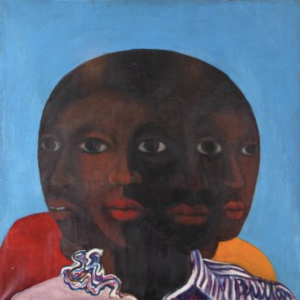Just Above My Wall, (To The Right), curated by Ciera Alyse McKissick, brings together Black collectors and SSCAC’s permanent collection.
Just Above My Wall, (To The Right), showcases Black contemporary artworks from 13 emerging and established Black art collectors from Chicago. During a time when Black artists and their work is in high demand, McKissick chose to highlight Black collectors who are invested in the preservation of Black art, much like the South Side Community Art Center’s mission and legacy.
This show encompasses parallelled histories between Black artists within the South Side Community Art Center’s collection, Black artists of today, and what Black art collectors are acquiring.
During a time when Black artists and their work is in high demand, McKissick chose to highlight Black collectors who are invested in the preservation of Black art, much like the South Side Community Art Center’s mission and legacy. Collector, Tracie Hall, describes her collection as “living with the ancestors.”
“I think that it’s important for us to demystify art because for me, the art that I live with charges my space. I think that our homes are almost like our safe harbor, and for me art is very spiritually charged,” Hall says. “I think that for Black people it’s important for us to really charge the space that we’re in, because a lot of times our spaces are so contested, our spaces are sometimes grabbed from us, or we’re displaced — the simple act of collecting art, or placing art in a place that you can see it, and letting it envelop you, is almost like resistance. I think that seeing art puts you in dialogue with something beyond yourself,” she said.

Work by Sylvester Britton from the South Side Community Art Center Permanent Collection.
Selected works from the SSCAC collection include Bill Walker, Ralph Arnold, Sylvester Britton, Yaounde Olu, Hale Woodruff, and Dorothy Higgenson-Carter among other works from the 20th century. Selected work from collectors include both emerging and established artists from the 21st century like, Krista Franklin, Hebru Brantley, Brandon Breaux, Alexandra Antoine, Erin Mitchell, and Lawrence Agyei to name a few.
For the curator, McKissick, who is also one of the emerging collectors featured, it was important to center the exhibition around collecting, and use the Center’s collection as a catalyst.
“Oftentimes when you think of an art collector or you see an art collector, the first thing you’re seeing is a rich white man or couple with money, and if you’re seeing a black collector, it’s someone famous like Jay-Z and Beyonce, Diddy, or Swizz Beats. While I am glad that celebrities are bringing the notion of owning art to the forefront, I think it also creates a misconception that you need to be of a certain caliber to collect artwork, or that it’s an unobtainable thing,” McKissick says. “I ideated the show around the Center’s collection because the space itself was created in that same vein. A group of college art students created this space because they didn’t see spaces that looked like them or represented them. Their collection is a representation of the hard work of those artists, and a sign that they were creating and existing, and so is the work of the artists these collectors are representing today.
Collectors Include: Patricia Andrews-Keenan, Janelle Miller, Stephanie Graham, John Ellis, Martha Wade, Tracie Hall, Drew Enstrumental, Raub Welch, Amanda Williams, Ayanah Moor, Alicia Goodwin, Rob McKay, and Ciera McKissick
Artists Featured From Their Collection: Solomon Adufah, Robert Pruitt/Thomas Lucas, Alexandria Valentine, SHENEQUA, John H. Blanton, Lawrence Agyei, Krista Franklin, Adler Guerrier, Max Sansing, David Anthony Geary, Alexandra Antoine, Hebru Brantley, Zephyr, Brandon Breaux, Paul S. Benjamin, Leasho Johnson, Erin Mitchell
*Image courtesy: Lawrence Agyei from the collection of John Ellis.



